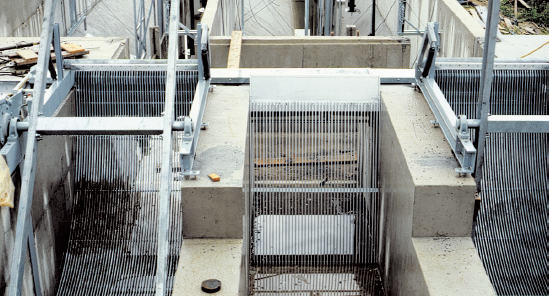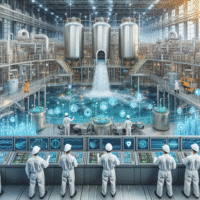Bar Screen In Wastewater Treatment

Bar Screens in Wastewater Treatment: A Comprehensive Overview
Introduction
Wastewater treatment is essential for maintaining the health of our environment and communities. Among the first steps in the treatment process is the removal of large solids and debris, a task commonly accomplished by bar screens. This comprehensive article delves into the intricacies of bar screens in wastewater treatment, exploring their design, operation, types, benefits, challenges, and advancements in technology.
What Are Bar Screens?
Bar screens are mechanical filtration devices employed in wastewater treatment facilities to remove large solid material from wastewater flows. They are typically the first line of defense in a treatment plant, capturing items such as rags, sticks, plastics, and other large debris that could potentially damage downstream equipment, clog systems, or disrupt biological processes.
The Importance of Bar Screens in Wastewater Treatment
Protecting Downstream Equipment
The primary function of bar screens is to protect subsequent treatment processes and equipment from damage. By intercepting large debris, bar screens prevent clogs and mechanical failures in pumps, pipes, and finer filtration systems. This protection is critical to maintaining the operational integrity and efficiency of the entire treatment facility.
Enhancing Treatment Efficiency
By removing large solids early in the treatment process, bar screens help enhance the overall efficiency of the wastewater treatment plant. Reducing the solids load on secondary treatment processes allows these systems to operate more efficiently, effectively, and without excessive wear and tear.
Regulatory Compliance
Meeting regulatory standards is a significant concern for wastewater treatment facilities. Bar screens play an essential role in ensuring that wastewater discharge meets environmental regulations by preventing large pollutants from entering natural water bodies. Compliance with these standards is crucial for protecting public health and the environment.
Design and Operation of Bar Screens
Basic Components
-
- Bars: The fundamental components of a bar screen are the parallel bars that create a grid to intercept debris. The spacing between the bars, known as the bar spacing, determines the screen’s capacity to filter out solids.
-
- Frame: The bars are mounted on a sturdy frame, typically made of stainless steel or other corrosion-resistant materials.
-
- Coarse and Fine Screens: Bar screens are categorized based on the spacing of the bars. Coarse screens have larger openings and capture bigger debris, while fine screens have smaller openings to intercept finer solids.
Installation and Placement
Bar screens are generally installed in the influent channels of wastewater treatment plants. Their placement ensures that large solids are removed from the wastewater flow early in the process. Bar screens can be installed at an angle to facilitate gravity-assisted cleaning and debris removal.
Mechanisms of Operation
-
- Manual Screens: In smaller or less complex facilities, manual bar screens may be used. These require periodic manual cleaning, typically by operators using rakes or other equipment.
-
- Mechanical Screens: Larger or more advanced facilities often employ mechanical bar screens that include automated cleaning mechanisms. These systems can vary in design, utilizing rakes, brushes, or other mechanical means to remove captured debris continuously or at set intervals.
Types of Bar Screens
Coarse Bar Screens
Coarse bar screens are the first line of defense and are designed to intercept large debris. They typically have bar spacings of 25 mm (1 inch) or greater. These screens are crucial for preventing significant blockages and protecting the initial stages of the treatment process.
Fine Bar Screens
Fine bar screens come into play after the coarse screens and have much smaller bar spacings, often in the range of 5-15 mm. These screens capture smaller solids that passed through the coarse screens, providing a more refined filtration of the wastewater before it proceeds to secondary treatment processes.
Inclined Bar Screens
Inclined bar screens are mounted at an angle, usually between 30 to 45 degrees from the vertical. This design facilitates gravity-assisted cleaning as debris slides down the screen and is easier to remove. The angle also helps maintain a constant water flow velocity across the screen surface.
Vertical Bar Screens
Vertical bar screens are set up straight within the influent channel. They are less common but are used in facilities with specific space constraints or design requirements. These screens require mechanical assistance for cleaning due to the vertical orientation of the bars.
Curved Bar Screens
Curved bar screens feature a concave or convex design, enabling a more compact installation and enhanced debris capture. This design can improve the efficiency of the screening process and is useful in facilities with limited space.
Challenges and Maintenance of Bar Screens in Wastewater Treatment
Common Challenges
-
- Debris Accumulation: Over time, debris can accumulate on the screen bars, reducing the effectiveness of the screening process and increasing the risk of clogged screens or water flow bypass.
-
- Mechanical Failures: The mechanical components of automatic bar screens, such as motors, rakes, and brushes, can fail due to constant exposure to harsh environmental conditions or poor maintenance.
-
- Corrosion: Corrosion is a persistent issue in the wet and chemically aggressive environment of wastewater treatment plants. Utilizing appropriate materials and protective coatings is essential to mitigate this problem.
-
- Power Supply Issues: Mechanical bar screens rely on a steady power supply. Any interruption can halt the screening process, necessitating manual intervention until power is restored.
Maintenance Practices
-
- Routine Inspections: Regular inspections of the bar screens and associated components are crucial. This practice helps identify wear and tear, corrosion, or any other issues that might impede the screen’s functionality.
-
- Cleaning: Periodic manual or automated cleaning is vital to prevent debris buildup. This maintenance ensures that the bar screen continues to operate efficiently.
-
- Lubrication: For mechanical bar screens, keeping moving parts well-lubricated reduces friction and wear, thereby extending the lifespan of the equipment.
-
- Replacement of Parts: Timely replacement of worn-out parts, such as rakes, brushes, motors, and bars, is necessary to maintain the functionality of mechanical bar screens.
Monitoring and Control Systems
Advanced wastewater treatment facilities employ monitoring and control systems to enhance the efficiency and reliability of bar screens. These systems can provide real-time data on screen performance, trigger automatic cleaning cycles, and alert operators to any malfunctions or maintenance needs, thus ensuring consistent operation.
The Future of Bar Screens: Technological Advancements
Smart Bar Screens
The integration of smart technology into bar screens has emerged as a significant development. Smart bar screens are equipped with sensors and IoT-enabled devices to monitor screen performance continuously. These systems can predict maintenance needs, optimize cleaning cycles, and provide detailed operational data to facility managers.
Enhanced Materials and Coatings
Innovations in materials science have led to the development of enhanced materials and coatings that improve the durability and corrosion resistance of bar screens. These advancements reduce maintenance costs and extend the lifespan of the screens.
Hybrid Screening Systems
Hybrid screening systems combine the features of traditional bar screens with additional filtration technologies, such as micro-screens or drum screens. These systems offer improved efficiency in debris removal and can handle a broader range of solid sizes, enhancing the overall treatment process.
Energy-Efficient Designs
Newer bar screen designs prioritize energy efficiency, incorporating features such as low-power motors, optimized mechanical operations, and energy recovery systems. These innovations align with the growing emphasis on sustainability and cost-effectiveness in wastewater treatment.
Modular and Customizable Bar Screens
Modular designs and customizable bar screens are becoming more prevalent, offering flexibility to wastewater treatment plants. These designs allow for easy expansion, upgrades, or adjustments to meet specific facility requirements and changing operational needs.
Case Studies: Implementation of Bar Screens in Various Facilities
Urban Wastewater Treatment Plant
An urban wastewater treatment plant serving a metropolitan area decided to upgrade its aging manual bar screens to automated mechanical screens. The new system, equipped with smart sensors and automatic cleaning mechanisms, significantly reduced manual labor and maintenance costs. The facility also reported fewer operational disruptions and improved treatment efficiency, highlighting the benefits of modern bar screen technology.
Industrial Wastewater Treatment Facility
An industrial facility dealing with high volumes of wastewater containing large solid particles implemented a combination of coarse and fine bar screens. The coarse screens captured the bulk of the large debris, while the fine screens provided additional filtration. This two-tier screening approach protected the facility’s sensitive downstream equipment and ensured compliance with stringent environmental regulations.
Small Community Wastewater Treatment Plant
A small community wastewater treatment plant faced challenges with frequent clogs and mechanical failures in its existing bar screens. By switching to inclined bar screens with enhanced corrosion-resistant materials, the plant improved its debris removal efficiency and reduced maintenance downtime. This upgrade demonstrated the importance of selecting the right bar screen design for specific facility needs.
Conclusion
Bar screens play a crucial role in the effective operation of wastewater treatment plants by removing large debris early in the process, thereby protecting downstream equipment and enhancing overall treatment efficiency. With various designs, from coarse and fine screens to inclined and vertical configurations, bar screens offer flexible solutions for different facility requirements.
However, challenges such as debris accumulation, mechanical failures, and corrosion necessitate regular maintenance and inspection. Technological advancements, including smart screens, enhanced materials, hybrid systems, and energy-efficient designs, are paving the way for more reliable and sustainable bar screen solutions.
Case studies from diverse facilities underscore the real-world benefits of implementing the appropriate bar screen technology. As the field of wastewater treatment continues to evolve, the integration of advanced bar screens promises to improve operational efficiency, reduce costs, and ensure compliance with environmental standards, ultimately contributing to a cleaner, healthier world.


